-
Sous Vide Time and Temperatures
Sous Vide Time and Temps
Sous Vide Time and Temps
Sous Vide Temps
- All Sous Vide Temperatures
- Sous Vide Beef Temperatures
- Sous Vide Chicken Temperatures
- Sous Vide Duck Temperatures
- Sous Vide Fish Temperatures
- Sous Vide Vegetables Temperatures
- Sous Vide Infusions Temperatures
- Sous Vide Lamb Temperatures
- Sous Vide Pork Temperatures
- Sous Vide Shellfish Temperatures
- Sous Vide Turkey Temperatures
- Recipes Recipes Recipes Recipes
- Getting Started Guides Getting Started Guides Getting Started
- Equipment and Tools Equipment and Tools Equipment Equipment and Tools
- More Resources More Resources Resources More Resources
Thickening Technique
More Modernist Techniques
Click here to get great sous vide content via email
This post may contain affiliate links. Read more.
Written by Jason Logsdon
 There are a wide variety of ways to thicken liquids. In Western cooking flour or another starch has traditionally been used, especially to make gravies. Reducing the liquid over heat is another common technique. Many of the modernist ingredients allow you thicken liquids more efficiently and without changing the flavor.
There are a wide variety of ways to thicken liquids. In Western cooking flour or another starch has traditionally been used, especially to make gravies. Reducing the liquid over heat is another common technique. Many of the modernist ingredients allow you thicken liquids more efficiently and without changing the flavor.
Table of Contents
- What Is Thickening?
- Why Thicken?
- Thickening Process
- Common Thickeners
- Uses of Thickening in Cuisine
- How it Works
- Common Ingredients Used for Thickening
What Is Thickening?Top
Thickening is a cooking technique which dates back to history and plays a significant role in the creation of sauces and various dishes. This method of cooking is characteristic of French cuisine; however it has been adopted into many other culinary arenas and has undergone a transformation. The earliest form of thickening was achieved through reduction. Later on the use of food additives was employed. Today, in modern cuisine a number of thickening agents are used in order to achieve this.
Thickening agents work to augment the viscosity of a liquid substance without significantly affecting its taste and various properties. More often than not, thickeners are dispersed in water and other polar solvents due to their hydrophilic nature. Most thickening agents are also temperature sensitive and require care when cooking. Too much heat exposure may cause a breakdown as well as burning and too little heat may result in an unpleasant taste together with the lack of ability to firm. Generally, thickening brings about certain characteristics in food.
Why Thicken?Top

There are several reasons for thickening a liquid.
Mouthfeel
One of the biggest reasons to thicken a liquid is to improve its mouthfeel. The mouthfeel is how a liquid feels on the tongue. Thickening it can add body and make it feel more rich and creamy than it typically would. Because of the extra mouthfeel added by many thickeners it is possible to reduce the amount of fats in the dish without a reduction in richness of taste.
Cling
By thickening a liquid, and raising its viscosity, we improve how well it clings to food. This helps when applying glazes, keeping sauces on one section of the plate, or evenly coating food.
Particle Suspension
Many sauces have solid particles in them, such as herbs, spices, or purees. Thickening the liquid helps hold these solids in suspension and prevents them from sinking or floating out of the liquid.
Stabilize Emulsions
When a liquid is thickened and used in an emulsion, like a vinaigrette, it helps stabilize it for a longer time. This makes thickeners a great way to add body to an emulsion while also stabilizing it.
Thickening ProcessTop

Even though there are many different kinds of thickeners, a similar process is used to thicken most liquids. Instructions for specific ingredients can be found in the section on Ingredients.
Dispersion
The first step is to disperse the thickener in the liquid you want to thicken. Dispersion is simply the act of evenly distributing the ingredient throughout the liquid. This will ensure the liquid will be thickened uniformly instead of clumping.
Some ingredients require special dispersion methods, such as combining flour with cold water before adding it to hot water to eliminate lumps. Depending on the ingredient, you may have to use a hot, cold, acidic, or other liquid for proper dispersion.
For some ingredients a whisk or spoon will work fine, others will need the stronger shearing forces of an immersion or standing blender.
Hydration
Once the thickener has been fully dispersed it needs to hydrate. Hydration is basically the process of absorbing water, or another liquid, and swelling. This absorption of liquid, in conjunction with other processes, causes the thickening of the mixture, creating a molecular mesh that traps water.
Depending on the thickener and the liquid being used, hydration will occur at different temperatures and over different time frames. Many ingredients will need to be heated for hydration to occur, like flour and carrageenan, and some will hydrate at any temperature, such as xanthan gum.
Setting
The final stage is when the liquid actually thickens. Many thickeners will only begin to work below a specific temperature, while others will work at any temperature. This process typically takes only a few minutes.
Common ThickenersTop

There are many different thickeners; the four main ones are listed below. For an extended look at any of these ingredients please see their entry in the Ingredients section.
Carrageenan
There are many types of carrageenan and they are good for both thickening dairy products and adding good mouthfeel. The liquid has to be heated before the carrageenan will hydrate.
Mono and Diglycerides
Mono and diglycerides are used to thicken and emulsify oils and fats. They are introduced by heating the oil and dissolving them into it.
Tapioca Maltodextrin
Commonly called N-Zorbit M or Texturas Malto, tapioca maltodextrin thickens oils. This can range from creating a light paste to a fine powder. It is commonly stirred or whisked into the oil until the desired texture is achieved.
Ultra-Sperse
Ultra-Sperse, or Ultra-Sperse M is a modified tapioca starch and is used in many of the same ways xanthan gum is used. It is very good for thickening liquids.
Ultra-Tex
Ultra-tex is very similar in use to xanthan gum. It can thicken liquids at most temperatures and often has a better mouthfeel than xanthan gum does at higher concentrations.
Xanthan Gum
A good all around thickener that hydrates at almost any temperature and within a wide pH range. It is commonly used at ratios of 0.2% to 1%, though it can result in an undesirable mouthfeel at high concentrations, almost resembling mucus. Because it hydrates and thickens very quickly it can be added slowly to a liquid until it obtains the thickness desired, removing the need to always weigh it.
Uses of Thickening in CuisineTop

The main role played by thickening in the realm of cooking, whether modern or classic, is to increase viscosity in fluids. As a result of this thickened state liquids are given a different appearance as well as texture. One of the biggest changes in appearance that thickened fluids may have is body. Any liquid that has not been stabilized will flow freely without taking on any specific shape. Thickeners function to hold together these loose fluids, allowing them to take shape, giving it mass and a physical structure by bulking it up. This will also give the substance a specific firmness that prevents the liquids from running out. In cooking, this will allow liquids to adhere, enriching the flavors available.
Another major role played by thickeners in cuisine is that of a binder. Specific ingredients may not bind freely together and becoming stable. High water and fat contents may often prevent ingredients from coming together. In other cases, solid ingredients may not have the capacity to stick to each other and may come apart during the cooking process. Thickeners such as vegetable gums and starches may also work as binding agents holding components together.
There's no forgetting that thickening also works to improve the dining experience through taste, texture and appearance. The usual runny liquid can be modified to create various consistencies. The process of increasing the thickness of liquids can result in lightness, creaminess, richness, fullness and many other food characteristics. Aside from this, dishes are made more enticing with the use of suspension and plating of thickened substances.
How it WorksTop

Food thickeners are classified as either polysaccharides or proteins. Regardless of this, both types of these food additives are known as hydrocolloids which are hydrophilic polymers. This name explains the behavior of the agents. Polymers are chains of molecules which are strung together. Being hydrophilic these molecule chains have a natural affinity to water. Hydrophilic polymers have a tendency to readily interact with water as these become dissolved in water and absorb moisture.
Molecules of such polymers are typically charge-polarized making them capable of hydrogen bonding. This explains why some thickening agents are better used with hot water or cooked with heat. Certain polymers react to hydrogen bonding more easily at higher temperatures causing the hydrocolloids to hydrate better with the presence of heat.
It is normal to have all hydrocolloids work together with water and as a result the diffusion of these is controlled and the presence becomes stabilized. Like other hydrocolloids, thickeners become individualized as they are hydrated causing molecules to become separated from each other. The hydrophilic polymer chains then unfurl and hydrophobic polymer chains become present. The overlapping area between the two types of chains causes water to become trapped in between stabilizing it. Since hydrocolloids have the capacity to attract water much more than its actual weight, the process of hydrogen bonding and hydration results in stabilization due to the prevention of crystallization, settling, separation and collapsing.
Common Ingredients Used for ThickeningTop
Under the polysaccharide type of thickeners there are three main kinds of thickening agents derived from plants.
Starches -Taken from the glucose produced by green plants in their plastids, this carbohydrate can be found in many different staple foods. Common sources of starches include maize, potato, arrow root, tapioca, cassava and wheat. These often come in a white powder form which does not have any taste or smell. Characteristics of starches vary with each one. For example, flour produces an opaque color, while cornstarch does not have any color. Tapioca starch will give off a glossy finish and arrow root starch works well with acidic substances.
Vegetable Gum - Natural gums which are able to cause viscosity even with small amounts are derived from various plants. These may be taken from the cells of seaweeds, sap or seeds of specific trees and bushes or made through the fermentation of certain bacterial species. Like starches, each of these natural gums has their own properties.
Pectin- Extracted primarily from citrus fruits, this white to brown powder is a source of dietary fiber. It is widely used as a thickening and gelling agent, most especially for jellies and jams. The natural acidity of this substance causes liquids to stiffen.
Another type of thickening agent which can be used for this technique is proteins. One example of which is eggs. Proteins have the ability to coagulate causing liquids to become trapped within the set network it has.
Thickening Recipes
Xanthan Thickened Roasted Tomato Salsa Recipe
 Salsas are a great way to add flavor to dishes. Roasting the vegetables first adds even more flavor to the salsa. Though if you're in a time crunch you can just use canned tomatoes and it will still turn out well. I love to serve this with a rich, heavy meat like lamb chops, chicken thighs, or braised beef. It can even work as a dip for chips!
Salsas are a great way to add flavor to dishes. Roasting the vegetables first adds even more flavor to the salsa. Though if you're in a time crunch you can just use canned tomatoes and it will still turn out well. I love to serve this with a rich, heavy meat like lamb chops, chicken thighs, or braised beef. It can even work as a dip for chips!
Pressure Cooker Brisket Peppered Beef Recipe
 The other day I was up for some Chinese food but I didn't feel like ordering the greasy, starchy takeout from around the corner so I decided to make some myself. I had some extra brisket in the freezer that I wanted to use up so I went for a pressure cooked version of Chinese Peppered Beef.
The other day I was up for some Chinese food but I didn't feel like ordering the greasy, starchy takeout from around the corner so I decided to make some myself. I had some extra brisket in the freezer that I wanted to use up so I went for a pressure cooked version of Chinese Peppered Beef.
Chilled Cantaloupe Soup with Pea Shoots
 At this time of cantaloupe is just starting to come into season. They are tender and sweet and barely resemble the bland and watery winter versions. The local farmers market recently had some "Sugar Kiss" melons that I couldn't resist.
At this time of cantaloupe is just starting to come into season. They are tender and sweet and barely resemble the bland and watery winter versions. The local farmers market recently had some "Sugar Kiss" melons that I couldn't resist.
Sous Vide Brisket Recipe with Cranberry BBQ Sauce
 Even though cranberries are a staple for Thanksgiving sauces they are often overlooked for more traditional sauces. Their combination of tartness and mild fruitiness is a great complement to many BBQ sauces. I like to serve this BBQ on a smoked and sous vided brisket.
Even though cranberries are a staple for Thanksgiving sauces they are often overlooked for more traditional sauces. Their combination of tartness and mild fruitiness is a great complement to many BBQ sauces. I like to serve this BBQ on a smoked and sous vided brisket.
How to Keep Sauces from Separating - Ask Jason
 A big issue with purees, sauces, and emulsions is that they separate over time. With the addition of some modernist ingredients, especially xanthan gum, you can delay this process.
A big issue with purees, sauces, and emulsions is that they separate over time. With the addition of some modernist ingredients, especially xanthan gum, you can delay this process.
Spinach-Garlic Dip Recipe
 This recipe turns a popular spinach-garlic dip into a foam for dipping. It can be served with roasted pita squares or even just vegetables and chips. This dip also works great as a sauce to perk up the flavors of steak or chicken.
This recipe turns a popular spinach-garlic dip into a foam for dipping. It can be served with roasted pita squares or even just vegetables and chips. This dip also works great as a sauce to perk up the flavors of steak or chicken.
Flank Steak with Chimichurri Recipe
 Flank steak is full of beefy flavor and has a great bite to it. Serving it with chimichurri, a spicy garlic and parsley based sauce, is very popular in Argentina and other South American countries. This recipe makes an excellent choice for a party!
Flank steak is full of beefy flavor and has a great bite to it. Serving it with chimichurri, a spicy garlic and parsley based sauce, is very popular in Argentina and other South American countries. This recipe makes an excellent choice for a party!
Sous Vide Turkey Breast with Cranberry Chutney
 This is a great meal anytime and pairs the sous vided moist and tender turkey with a sweet and sour cranberry chutney. Always a family favorite!
This is a great meal anytime and pairs the sous vided moist and tender turkey with a sweet and sour cranberry chutney. Always a family favorite!
Easy Aioli Dip Recipe
 Aioli is simply a mayonnaise made with garlic and olive oil. This recipe uses an immersion blender to make the process super-easy and results in a light dip for vegetables or a spread on breads and toast. It's a popular addition to any party fare!
Aioli is simply a mayonnaise made with garlic and olive oil. This recipe uses an immersion blender to make the process super-easy and results in a light dip for vegetables or a spread on breads and toast. It's a popular addition to any party fare!
Cranberry Chutney Crostini Recipe
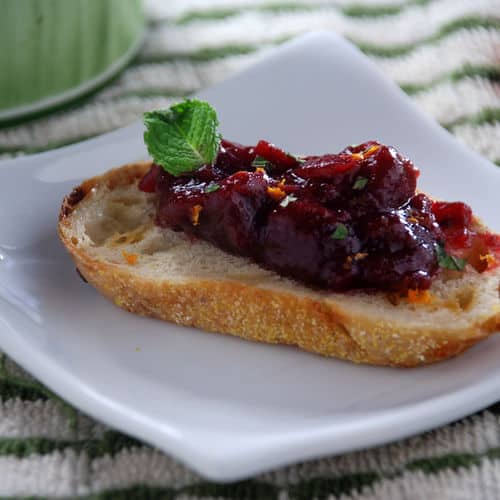 Cranberries are a great treat any time of the year. This recipe combines the tang from the cranberries with the smokiness from the ancho pepper. For a burst of flavor place on a crispy crostini and topped with with spices and mint. A great party treat!
Cranberries are a great treat any time of the year. This recipe combines the tang from the cranberries with the smokiness from the ancho pepper. For a burst of flavor place on a crispy crostini and topped with with spices and mint. A great party treat!
Pork and Roasted Strawberry Salad Recipe
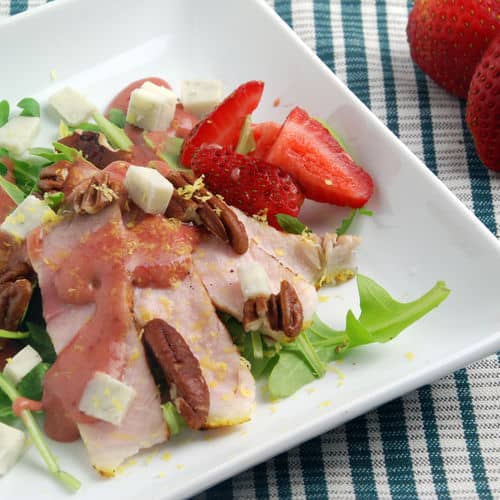 For this recipe I roast the strawberries then puree them to form a sweet and tangy salad dressing. For a different flavor combination I serve it over a savory pulled pork and arugula salad.
For this recipe I roast the strawberries then puree them to form a sweet and tangy salad dressing. For a different flavor combination I serve it over a savory pulled pork and arugula salad.
Shredded Beef with Spicy Tangerine Froth Recipe
 This recipe uses the pressure cooker to turn an inexpensive chuck roast into a moist,flavor-packed beef entree and the whipping siphon to prepare a spicy tangerine froth topping. It's a fun and simple meal that will impress your family and dinner guests alike.
This recipe uses the pressure cooker to turn an inexpensive chuck roast into a moist,flavor-packed beef entree and the whipping siphon to prepare a spicy tangerine froth topping. It's a fun and simple meal that will impress your family and dinner guests alike.
Sous Vide Honey-Chipotle Glazed Country Style Ribs
 This sous vide country style ribs recipe uses a honey-chipotle glazed to perk up the flavor of the dish. For a thicker, clingier sauce on your ribs, adding a tad of xanthan gum will make that happen!
This sous vide country style ribs recipe uses a honey-chipotle glazed to perk up the flavor of the dish. For a thicker, clingier sauce on your ribs, adding a tad of xanthan gum will make that happen!
Mango Foam
 Versawhip and xanthan gum combine to make light
foams that are a great way to add texture to dishes.
It's a great topping for desserts and ice creams or can
even be eaten as an amuse bouche between dishes.
Versawhip and xanthan gum combine to make light
foams that are a great way to add texture to dishes.
It's a great topping for desserts and ice creams or can
even be eaten as an amuse bouche between dishes.
Sous Vide Bourbon-Maple Chutney
 This apple chutney is a very flavorful topping that provides a savory punch to pork, fish or even on a dessert! This recipe sous vides the apples in a bourbon, maple syrup, chipotle and thyme mixture.
This apple chutney is a very flavorful topping that provides a savory punch to pork, fish or even on a dessert! This recipe sous vides the apples in a bourbon, maple syrup, chipotle and thyme mixture.
Roasted Parsnips with Carrot Froth Recipe
 Roasting parsnips gives it an almost nutty taste, which holds up well to a topping of chipotle-carrot froth. The modernist ingredient of xanthan gum is used in the froth to help it retain the bubbles generated in the whipping siphon. This is a fun dish to serve as an appetizer or starter plate.
Roasting parsnips gives it an almost nutty taste, which holds up well to a topping of chipotle-carrot froth. The modernist ingredient of xanthan gum is used in the froth to help it retain the bubbles generated in the whipping siphon. This is a fun dish to serve as an appetizer or starter plate.
Chocolate Covered Mint Marshmallows
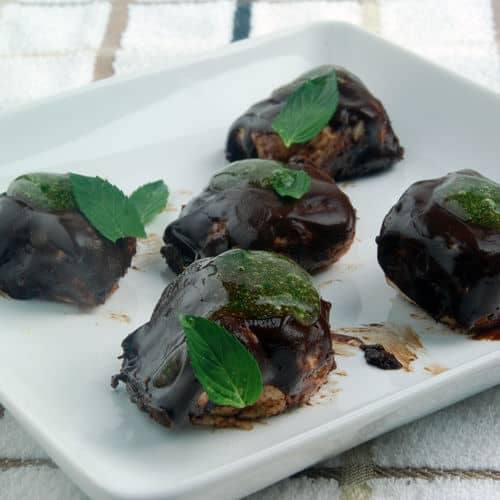 This recipe takes classic homemade marshmallows and covers them in yummy chocolate. Mint and chocolate is a classic pairing and the soft marshmallows are a great way to hold them all together! A definite party favorite!
This recipe takes classic homemade marshmallows and covers them in yummy chocolate. Mint and chocolate is a classic pairing and the soft marshmallows are a great way to hold them all together! A definite party favorite!
Honey-Chipotle BBQ Sauce Recipe
 When I'm having wings I almost always reach for the honey-chipotle BBQ sauce. It's a delicate balance between the heat from the chipotles and the sweetness from the honey. Just be sure to make plenty, your guests will love it!
When I'm having wings I almost always reach for the honey-chipotle BBQ sauce. It's a delicate balance between the heat from the chipotles and the sweetness from the honey. Just be sure to make plenty, your guests will love it!
Sous Vide Beer Brat Grinders with Guinness Mustard
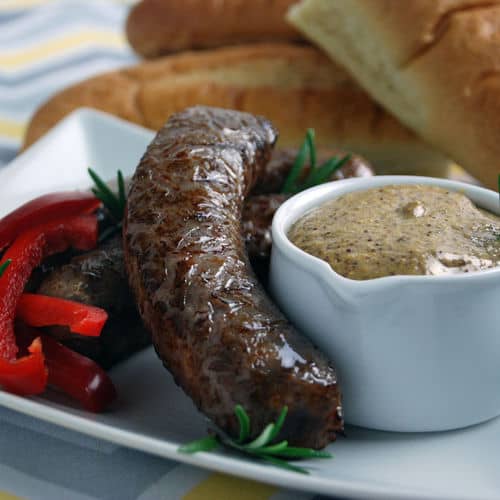 Beer braised brats are a great summertime BBQ dish. I really like it served with a strongly flavored Guinness mustard on a toasted bun with grilled peppers and onions. Since the grill is already hot from the veggies, finish the brats with a quick sear to caramelize the outside and enjoy!
Beer braised brats are a great summertime BBQ dish. I really like it served with a strongly flavored Guinness mustard on a toasted bun with grilled peppers and onions. Since the grill is already hot from the veggies, finish the brats with a quick sear to caramelize the outside and enjoy!
Pea Pesto Recipe
 This recipe makes a clean and fresh tasting pea pesto dip that works great with just about everything, especially grilled sourdough bread, carrot and celery sticks, as well as roasted vegetable chips. This party favorite is quick and easy to put together and can be made with defrosted frozen peas - however, if you have access to fresh spring peas it'll be even better!
This recipe makes a clean and fresh tasting pea pesto dip that works great with just about everything, especially grilled sourdough bread, carrot and celery sticks, as well as roasted vegetable chips. This party favorite is quick and easy to put together and can be made with defrosted frozen peas - however, if you have access to fresh spring peas it'll be even better!
Sous Vide Sirloin Steak with Lime-Ginger Slaw
 This recipe combines lime and ginger which are two great ingredients to pair with the bold flavors of the sous vided sirloin steak. I like to add texture and brightness to the dish by combining them in a vinaigrette-style sauce that is drizzled over a crispy cabbage and pepper slaw topping.
This recipe combines lime and ginger which are two great ingredients to pair with the bold flavors of the sous vided sirloin steak. I like to add texture and brightness to the dish by combining them in a vinaigrette-style sauce that is drizzled over a crispy cabbage and pepper slaw topping.
Chicken with Teriyaki Froth Recipe
 This recipe tops sous vided chicken with a modernist froth to make a favorite dish that even pickier eaters tend to gobble up! By using xanthan gum in the teriyaki sauce you can turn it into a flavorful froth in a whipping siphon. Even a "basic" food can be the talk of the party!
This recipe tops sous vided chicken with a modernist froth to make a favorite dish that even pickier eaters tend to gobble up! By using xanthan gum in the teriyaki sauce you can turn it into a flavorful froth in a whipping siphon. Even a "basic" food can be the talk of the party!
Sous Vide Shredded Duck Legs with Sesame Noodles
 What to serve your guests something a little different but exceptional for dinner? In this dish I topped sesame noodles with shredded duck legs because they can hold up to the strong flavors of the pasta. You can serve this entree either hot or cold. It's sure to be a hit!
What to serve your guests something a little different but exceptional for dinner? In this dish I topped sesame noodles with shredded duck legs because they can hold up to the strong flavors of the pasta. You can serve this entree either hot or cold. It's sure to be a hit!
Pork with Roasted Apple Pudding Recipe
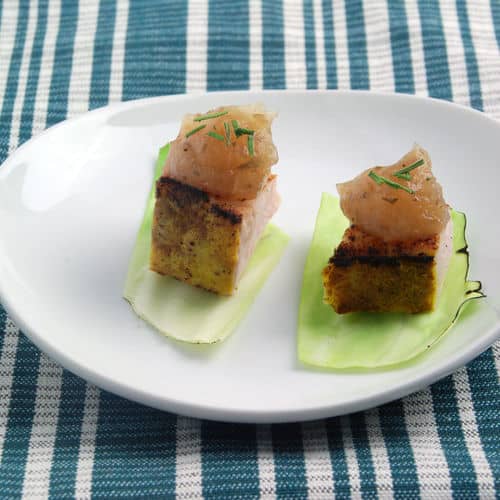 The combination of apples and pork are a classic pairing in Irish cooking. For this recipe, I roast apples and use the modernist ingredient of agar to turn them into a fun pudding topper for pork. By sous vide cooking the pork, you can consistently serve an extra moist and tender meat entree.
The combination of apples and pork are a classic pairing in Irish cooking. For this recipe, I roast apples and use the modernist ingredient of agar to turn them into a fun pudding topper for pork. By sous vide cooking the pork, you can consistently serve an extra moist and tender meat entree.
Sous Vide Tarragon, Lemon, and Shallot Vinaigrette
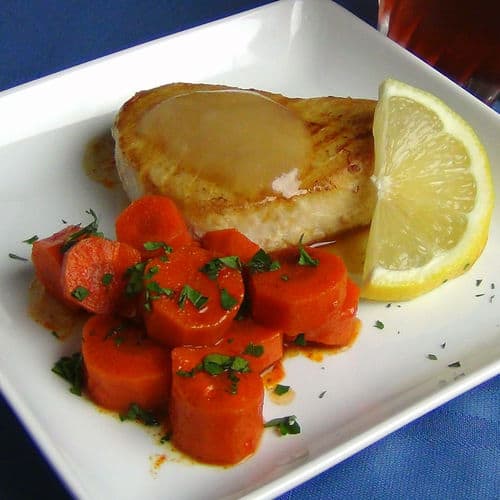 This recipe infuses the flavors of shallot, lemon, and tarragon into a vinegar and then makes it into a light, bright vinaigrette. This pairing adds several base layers of flavor to the fish. For a modernist twist, thicken it into a sauce with xanthan gum!
This recipe infuses the flavors of shallot, lemon, and tarragon into a vinegar and then makes it into a light, bright vinaigrette. This pairing adds several base layers of flavor to the fish. For a modernist twist, thicken it into a sauce with xanthan gum!
Blackberry-Peach Wrapped Pork Recipe
 The star of most of my parties is meat and this blackberry-peach wrapped sous vided pork offering is no exception! It makes a fun presentation besides the additional sweetness and flavor from roasting the fruit complements the pork perfectly.
The star of most of my parties is meat and this blackberry-peach wrapped sous vided pork offering is no exception! It makes a fun presentation besides the additional sweetness and flavor from roasting the fruit complements the pork perfectly.
White Bean Puree with Rosemary Oil Recipe
 This recipe is a great crostini topping for any party, especially if some attendees might be less adventurous eaters! It resembles a more traditional dish but it have a subtle modernist touch. Garnishing the white bean puree with lemon zest pulls in even more highlights to the food.
This recipe is a great crostini topping for any party, especially if some attendees might be less adventurous eaters! It resembles a more traditional dish but it have a subtle modernist touch. Garnishing the white bean puree with lemon zest pulls in even more highlights to the food.
Sous Vide Salmon Recipe with Apple and Jalapenos
 Sous vide salmon is a tender, soft meat that can be unlike anything cooked in a traditional manner. I pair it with spicy jalapenos and sous apples for a tart, rich dish.
Sous vide salmon is a tender, soft meat that can be unlike anything cooked in a traditional manner. I pair it with spicy jalapenos and sous apples for a tart, rich dish.
Sous Vide Asparagus Recipe with Dijon Mustard Vinaigrette
 Sous vide asparagus is similar to blanched asparagus but ends up with a stronger flavor and slightly firmer texture. It only needs a short cooking time unless the asparagus is really thick.
Sous vide asparagus is similar to blanched asparagus but ends up with a stronger flavor and slightly firmer texture. It only needs a short cooking time unless the asparagus is really thick.
Sous Vide Tri-Tip Recipe with Roasted Fennel and Orange Salad
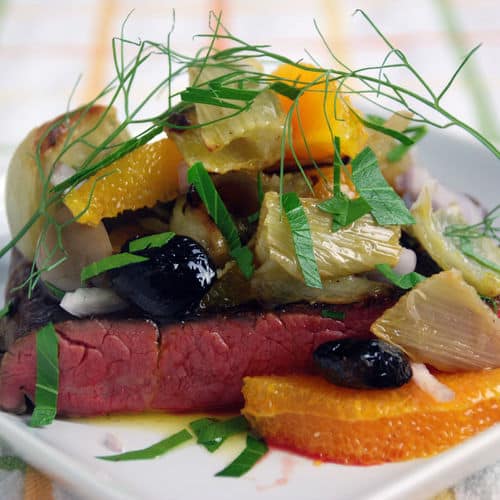 This sous vide tri-tip steak recipe takes full advantage of the rich, meaty cut and is tenderized through the sous vide process and pared with an exotic fennel, orange, and olive salad.
This sous vide tri-tip steak recipe takes full advantage of the rich, meaty cut and is tenderized through the sous vide process and pared with an exotic fennel, orange, and olive salad.
Seared Tuna Squares Recipe
 By using the basic modernist ingredient of xanthan gum this recipe turns tuna into an upscale party favorite for any gathering. I serve the tuna squares with a pickled pear relish and an Asian accent sauce for a pop of flavor.
By using the basic modernist ingredient of xanthan gum this recipe turns tuna into an upscale party favorite for any gathering. I serve the tuna squares with a pickled pear relish and an Asian accent sauce for a pop of flavor.
Pulled Pork with Spicy Pineapple Chutney Recipe
 This pulled pork recipe takes a tropical turn with pineapples, chiles, cilantro, and lime juice. This versatile dish can be served as an appetizer or main dish and either hot or cold.
This pulled pork recipe takes a tropical turn with pineapples, chiles, cilantro, and lime juice. This versatile dish can be served as an appetizer or main dish and either hot or cold.
Habanero-Peach Dip Recipe
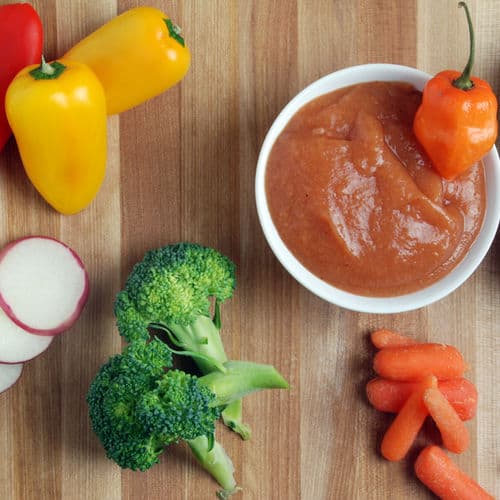 This dip recipe combines the spicy heat of habanero peppers with the sweet taste of fresh ripe peaches. The resulting tangy dip is great on vegetables or even meat. By altering the amount of peppers used, you can raise or lower the heat to suit your guests.
This dip recipe combines the spicy heat of habanero peppers with the sweet taste of fresh ripe peaches. The resulting tangy dip is great on vegetables or even meat. By altering the amount of peppers used, you can raise or lower the heat to suit your guests.
Watermelon Soup Recipe With Pickled Rind
 When watermelon is in season it's hard to resist. For some parties you need nothing more than to slice it and hand it out with paper towels for people to scarf down. However, sometimes you want something a little more refined and that's where this recipe comes in.
When watermelon is in season it's hard to resist. For some parties you need nothing more than to slice it and hand it out with paper towels for people to scarf down. However, sometimes you want something a little more refined and that's where this recipe comes in.
Sparkling Grape Gazpacho Recipe
 Sweet green grapes are another favorite snack of mine and they're a great party food because most people really like them. For this more upscale dish I turn them into a sweet, fizzy soup. The xanthan gum helps hold the particles in suspension and the carbonation effect adds a pleasant tingle and tang to it.
Sweet green grapes are another favorite snack of mine and they're a great party food because most people really like them. For this more upscale dish I turn them into a sweet, fizzy soup. The xanthan gum helps hold the particles in suspension and the carbonation effect adds a pleasant tingle and tang to it.
Lemonade Recipe with Blueberry Froth
 This modernist recipe is a refreshing take on blueberry lemonade that changes the ubiquitous summer drink into a modernist creation your friends will love. It is a light blueberry froth dispensed on top of a glass of lemonade. The blueberry foam slowly filters into the drink, changing the flavor of the lemonade the longer you drink it. It is a quick recipe to make and is a great way to elevate a common drink.
This modernist recipe is a refreshing take on blueberry lemonade that changes the ubiquitous summer drink into a modernist creation your friends will love. It is a light blueberry froth dispensed on top of a glass of lemonade. The blueberry foam slowly filters into the drink, changing the flavor of the lemonade the longer you drink it. It is a quick recipe to make and is a great way to elevate a common drink.
Aquarium Pump Grape Bubbles Recipe
 There are many different types of foams you can make using different modernist ingredients and foaming methods. This foam resembles bubbles and is made with xanthan gum and Versawhip that has been aerated with an aquarium pump. It's a pretty unique way to make bubbles and they are very interesting.
There are many different types of foams you can make using different modernist ingredients and foaming methods. This foam resembles bubbles and is made with xanthan gum and Versawhip that has been aerated with an aquarium pump. It's a pretty unique way to make bubbles and they are very interesting.
Ultra-Tex
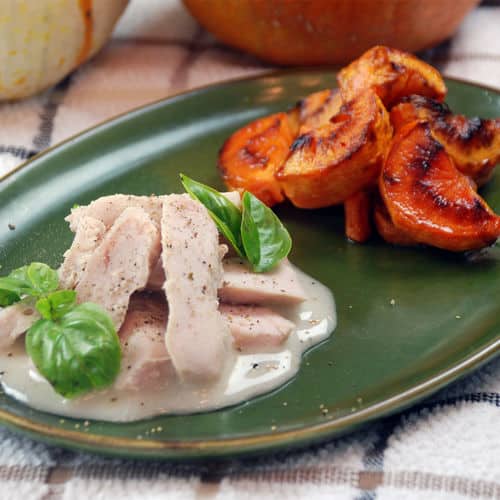 Ultra-tex is very similar in use to xanthan gum. It can thicken liquids at most temperatures and often has a better mouthfeel than xanthan gum does at higher concentrations.
Ultra-tex is very similar in use to xanthan gum. It can thicken liquids at most temperatures and often has a better mouthfeel than xanthan gum does at higher concentrations.
Ultra-Sperse
 Ultra-Sperse is an all-natural starch used in the culinary world in many of the same ways xanthan gum is used. It is very good for thickening liquids.
Ultra-Sperse is an all-natural starch used in the culinary world in many of the same ways xanthan gum is used. It is very good for thickening liquids.
Salmon Bites with Tomatillo Agar Fluid Gel Sauce Recipe
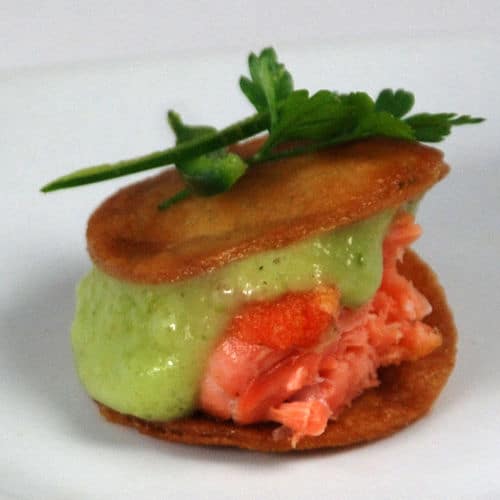 These Mexican inspired salmon bites pack a lot of flavor in a little package. The acidity from the tomatillos compliments the salmon perfectly and the crunch from the fried tortillas adds great texture.
These Mexican inspired salmon bites pack a lot of flavor in a little package. The acidity from the tomatillos compliments the salmon perfectly and the crunch from the fried tortillas adds great texture.
Roasted Red Pepper Pesto Recipe
 Not all dishes that use modernist ingredients have to be super fancy in-your-face dishes that look like they came from Alinea. This red pepper pesto crustini is a great example. It is a simple, hearty snack that is great when served as an appetizer or set out as hors d'oeuvres.
Not all dishes that use modernist ingredients have to be super fancy in-your-face dishes that look like they came from Alinea. This red pepper pesto crustini is a great example. It is a simple, hearty snack that is great when served as an appetizer or set out as hors d'oeuvres.
Xanthan Strengthened Maple Vinaigrette Recipe
 This is a simple modernist vinaigrette to make and utilizes both xanthan gum and lecithin to strengthen and thicken it. I really like the sweet maple syrup with the tangy balsamic vinegar. This goes well on salads, especially ones with berries. You can also add a little more xanthan gum and use the vinaigrette as a sauce on fish or chicken.
This is a simple modernist vinaigrette to make and utilizes both xanthan gum and lecithin to strengthen and thicken it. I really like the sweet maple syrup with the tangy balsamic vinegar. This goes well on salads, especially ones with berries. You can also add a little more xanthan gum and use the vinaigrette as a sauce on fish or chicken.
Cherry Whipped Methocel Foam Recipe
 Modernist foams come in many varieties. They can be made by blending, in a whipping siphon, or even using an aquarium bubbler. This recipe focuses on a different type: whipped foams, specifically whipped Methocel foams.
Modernist foams come in many varieties. They can be made by blending, in a whipping siphon, or even using an aquarium bubbler. This recipe focuses on a different type: whipped foams, specifically whipped Methocel foams.
Xanthan Gum
 Xanthan gum, or just xanthan, is one of the easiest ingredients to work with. It is used extensively to thicken liquids; a great ingredient used to turn thin liquids into savory sauces. It quickly hydrates or disperses at any temperature, making it one of the few ingredients you can add slowly and instantly see the result. Also, xanthan gum does not lose its properties when microwaved.
Xanthan gum, or just xanthan, is one of the easiest ingredients to work with. It is used extensively to thicken liquids; a great ingredient used to turn thin liquids into savory sauces. It quickly hydrates or disperses at any temperature, making it one of the few ingredients you can add slowly and instantly see the result. Also, xanthan gum does not lose its properties when microwaved.
Xanthan Gum Banana Milkshake Recipe
 Xanthan gum is a great thickener and can be used with a variety of foods. Making low fat milk shakes is a great way to use it. Here we make a low fat banana milk shake.
Xanthan gum is a great thickener and can be used with a variety of foods. Making low fat milk shakes is a great way to use it. Here we make a low fat banana milk shake.
Xanthan Gum Balsamic Vinegar Syrup Recipe
 One of the nice things about modernist cuisine is being able to thicken liquids without significantly diluting the flavor of them. There are several ingredients that can do this and here I use xanthan gum to make a balsamic vinegar syrup.
One of the nice things about modernist cuisine is being able to thicken liquids without significantly diluting the flavor of them. There are several ingredients that can do this and here I use xanthan gum to make a balsamic vinegar syrup.
Sesame Oil Powder Recipe
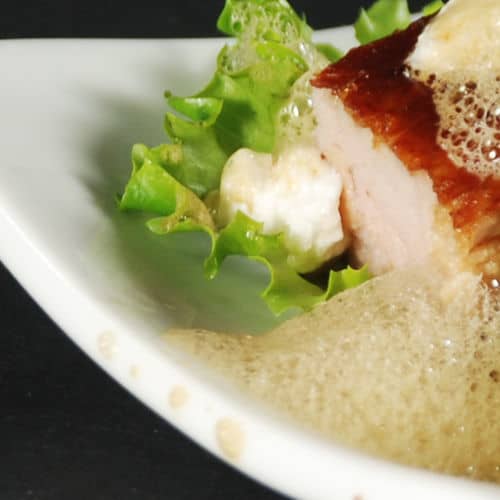 An easy way to get started with molecular gastronomy or modernist cuisine is through the creation of tapioca maltodextrin powders. Tapioca maltodextrin is simply a extremely fine powder that acts as a thickener when mixed with fat. This modernist recipe focuses on making a sesame oil powder.
An easy way to get started with molecular gastronomy or modernist cuisine is through the creation of tapioca maltodextrin powders. Tapioca maltodextrin is simply a extremely fine powder that acts as a thickener when mixed with fat. This modernist recipe focuses on making a sesame oil powder.
Simple Balsamic Vinegar Pearls Recipe and How to Guide
 One of the easiest molecular gastronomy recipes to try is by creating "pearls". Most pearls are solid jelly balls that can be used to garnish dishes or as an amuse-bouche. Here we use sweet-sour balsamic vinegar to make pearls that are a great way to add a hit of flavor to many different dishes. The process of making them is even pretty easy.
One of the easiest molecular gastronomy recipes to try is by creating "pearls". Most pearls are solid jelly balls that can be used to garnish dishes or as an amuse-bouche. Here we use sweet-sour balsamic vinegar to make pearls that are a great way to add a hit of flavor to many different dishes. The process of making them is even pretty easy.
 This article is by me, Jason Logsdon. I'm an adventurous home cook and professional blogger who loves to try new things, especially when it comes to cooking. I've explored everything from sous vide and whipping siphons to pressure cookers and blow torches; created foams, gels and spheres; made barrel aged cocktails and brewed beer. I have also written 10 cookbooks on modernist cooking and sous vide and I run the AmazingFoodMadeEasy.com website.
This article is by me, Jason Logsdon. I'm an adventurous home cook and professional blogger who loves to try new things, especially when it comes to cooking. I've explored everything from sous vide and whipping siphons to pressure cookers and blow torches; created foams, gels and spheres; made barrel aged cocktails and brewed beer. I have also written 10 cookbooks on modernist cooking and sous vide and I run the AmazingFoodMadeEasy.com website.
Affiliate Disclaimer: Some links on this site might be affiliate links that if used to purchased products I might receive money. I like money but I will not endorse something I don't believe in. Please feel free to directly go to any products I link to and bypass the referral link if you feel uncomfortable with me receiving funds.













